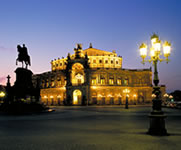In the "green heart" of Germany visitors can explore German cultural and intellectual history in all its intricacy. The literary era of classicism left its mark more indelibly on Thuringia than on any other region in Germany, so it is the natural setting for the Classics Route, a 350km circular route that winds its way from one classical town to the next. But the Classics Route is a route with a difference - there is no fixed starting point or specific final destination. Instead the route runs through central Thuringia like a sideways figure of eight, opening up a unique combination of natural beauty and historical towns and villages.
This is the region where philosophers and educationalists like Brentano, Fichte, Hegel and the Humboldt brothers influenced the course of human thought, and where Lucas Cranach and Otto Dix lived and worked. Religious figures of the stature of St. Elisabeth and Martin Luther, musicians like Bach, Liszt and Walther von der Vogelweide and Germany's "national poets" Goethe and Schiller all flourished here through the patronage of universities, abbeys and wealthy royal courts. The region's castles, palaces, fortresses, churches and abbeys were designed and built by distinguished master architects. Eisenach, set in the gentle hills of the Thuringian Forest, is the town where Johann Sebastian Bach was born, where Martin Luther went to school and is also the adopted home of writer Fritz Reuter. During the 13th century, Wartburg Castle was the pre-eminent centre of artistic endeavour and the venue for the epic minnesinging contest, a highlight of secular medieval culture. It also saw the emergence of immortal works of world literature. The castle's most famous resident, Martin Luther, translated the New Testament into German during his stay.



